While some are supping on sushi in Seattle, I'm down in the Napa Valley attending the Culinary Institute of America's Worlds of Flavor International Conference & Festival, with this year's theme being "Japan: Flavors of Culture."
And while I was especially amused seeing Masaharu Morimoto and Hiroyuki Sakai yukking it up, I must say there's an incredible number of amazing chefs, Iron and otherwise, doing presentations and preparing food. Many of the masters from Japan are here, along with the likes of Thomas Keller, David Chang, and Chris Cosentino from the States.
Yoshiki Tsuji, president of the Tsuji Culinary Institute in Osaka, gave the opening keynote. His look at traditions and innovations of Japanese cuisine was jam-packed with facts, philosophy, and a bit of fun. For example, while Japan is roughly the same size as California, the country has 50 percent more coastline than our entire country, which helps explain (along with other factors he outlined) the popularity of seafood there....
(You're taking pictures of the bird again, right? So here's Lou's Tips again, republished from last year this time.)
A little while ago, the fine photographic folks at Olympus put us in touch with Lou Manna, "Olympus Digital Visionary Photographer," for a story on photographing holiday meals.
If you're a foodie, it's likely you've already run into Lou Manna's food photography; he shot for the New York Times for 20 years.
Now he's got his own Fifth Avenue food photography studio, which is where he works with corporate, advertising, and restaurant clients, using (it must be noted) Olympus E-System cameras and flashes. Check out his website www.loumanna.com and blog www.digitalfoodphotography.com.
Since a picture is worth a thousand words, we talked Lou in to a photo essay. Click through each photo for a tip on how it's done. We can vouch for the "good enough to eat" part.
Here's Lou to get things started:
You’ve spent two days baking all of your holiday goodies… Finally on Thanksgiving Day, the turkey is ready to be gobbled up. Now you want your sweet labor to translate well in photographs. If you follow some of the following tips, then the pictures of your feast will look good enough to eat!...
(more)
Seattle's first Hard Rock Cafe, located at 116 Pike Street, is open for business today, as of 11 a.m. Josh and Audrey went on a tour yesterday (see full photo gallery); after the fact, they discussed the tech-heavy new digs, the tons of memorabilia, and the unironically awesome rooftop deck.
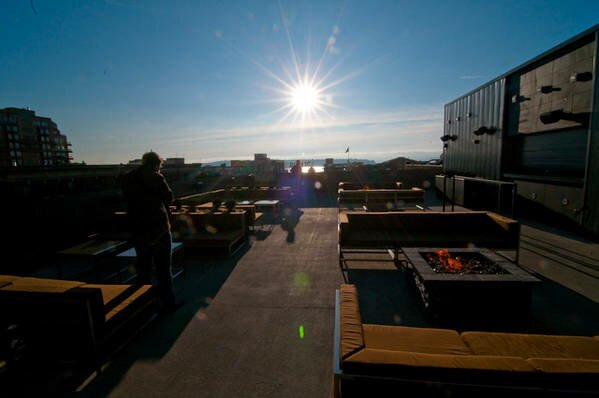 The third floor is home to a magnificent roof deck with views of the market and sound and populated with weatherized couches and firepits. This is the feature most likely to make you a Hard Rock Cafe regular.
The third floor is home to a magnificent roof deck with views of the market and sound and populated with weatherized couches and firepits. This is the feature most likely to make you a Hard Rock Cafe regular.
Josh: Let me begin by saying that before I saw that this place was under construction, I was not entirely aware that the Hard Rock Cafe was still in business, let alone opening new stores. Score one for the themed casual chain dining economy; times aren't as tough as I'd assumed.
Audrey: According to the Hard Rock's Wikipedia page, these are the other cities getting a new Cafe this year: Costa Maya, Los Angeles (Hollywood Blvd), and Krakow. To which I say: Seattle: Slightly More Culturally Advanced Than Krakow. Even Ho Chi Minh City got their Hard Rock last year!
Josh: We had no idea what we were missing! But I wonder if the EMP was strong-arming them out of the city for all of these years?
Audrey: A knife fight between the two awaits for sure. How did the EMP not get custody of Jimi Hendrix's green hat? Which brings us to a very important topic: memorabilia, though everyone at the Hard Rock likes to refer to it as "memo."
Josh: That's what it's all about: the stories. It is also the part of the HRC experience that is kind of baffling. It's as if someone realized one day that the biggest flaw in most museum experiences is the absence of a Hickory BBQ Bacon Cheeseburger on hand. Or, that what most restaurants were lacking were sufficient distractions from the usual dining experience. This is where the revamped HRC really shines. They know that obsessive music fans can be a little introverted.
Audrey : The Hard Rock Cafe seems to be the best place to go if you don't wish to interact with your dining companions (in other words, families on vacation).
Josh: TRUE. So they answer this by setting up those booths with the family/friends/social contact avoidance devices.
Audrey: Why talk as a family if Bobby can be voting on which video should be shown throughout the restaurant, while Mom takes a handheld survey on her dining experience thus far, and Dad is on his phone having a voicemail tour of the objects around him?
Josh: The family that avoids together stays together. Those screens are perfect for the surly teen who doesn't yet have an iPhone/iPad/iPod but still wants to see pictures of "memo" on display in Fiji, where he would have preferred the family take its annual vacay....
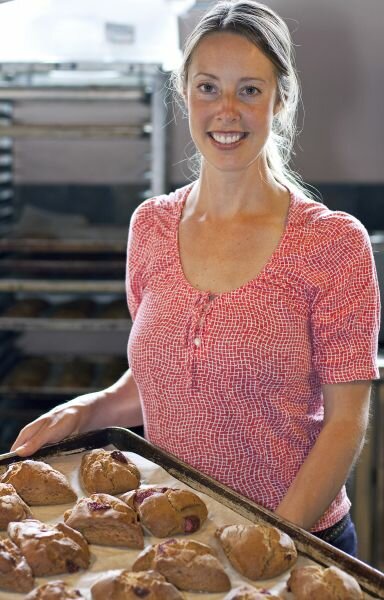 Jennifer Katzinger (Photo: Rachelle Longé)
Jennifer Katzinger (Photo: Rachelle Longé)
"I had been exposed to gluten-free at a juice bar in Greenlake years ago, and I was baking there and I really had fun working with all their different flours, and so I was just familiar with other grains," Jennifer Katzinger said. "And so I just got thinking, there are so many baked goods you can get in the Northwest, but finding a baked good that is with whole grains, or dairy and egg-free was hard. Organic too. Hence the Flying Apron."
Katzinger and I were sitting in the corner of the Walnut Street Coffeehouse in Edmonds, her nine-month-old daughter Lily, wearing a white knit sweater, playing on the seat between us. Charming and enthusiastic, Katzinger was telling me about the genesis of her vegan, gluten-free bakery, which she opened with her father in the University District in 2002. Eight years and two moves later, the Flying Apron is still going strong, and in addition to recently becoming a mother, Katzinger is now an author: in November, Sasquatch Books published her first cookbook, Flying Apron's Gluten-Free and Vegan Baking Book ($21.95).
A Northwest native, Katzinger grew up baking. In her early teens, she was already working at Lake Street Bakery ("That was a warm and cozy and delicious atmosphere, and I felt so safe there"), but after getting her BA in English Lit at the UW, she pursued a degree in industrial design at the Pratt Institute in NYC before returning to Seattle. When her and her father, both in need of new career directions, decided over coffee one morning to open the Flying Apron together, the concept wasn't as expressly gluten-free as it eventually became. While Katzinger was an on-and-off again vegan, originally the bakery featured a couple items that used egg and dairy--the idea was to have something for everyone, and the gluten- and wheat-free products were as much a creative touch as a conscious choice.
What led Katzinger to purge her work of gluten and wheat was the ecstatic response of customers. Wheat and gluten intolerance are actually common allergies, and on top of that, there's Celiac disease, in which wheat gluten wreaks havoc on the small intestine. The responses of her customers, some of whom would burst into tears when they found themselves in a bakery they could actually eat at, deeply affected her.
"The symptoms are so broad and different," Katzinger told me of the various stories her customers have shared. "One woman, a really beautiful woman who'd come to the bakery often, she traveled for work a lot, and she had been gluten-free for a long time, and had to go to Italy on business. And she thought, 'What the heck? I'm going to have the lasagna.' And for her, it was actually something like a schizophrenic type of situation. She had an episode, and just realized she can't go down that road."
"And other people, it just took them so long to be diagnosed Celiac. I remember this young woman coming in, I think she was going to the UW, and for years she was going to the hospital with digestive issues. And they would say, 'Oh, you need to eat more bran.' And so she would eat more bran and keep going in, and they would say, 'Oh, I think maybe you have something mentally going on, because we don't see anything wrong with you, and yet you keep complaining about your digestive issues.' So they put her on anti-depressants, and she went to Bastyr after that, where they did an allergy test and a Celiac test, and said, 'You have Celiac, there's no reason for you to be on anti-depressants.' So there's some really unusual stories out there, but in the U.S. they're pretty common. I think it takes, on average, 11 years to be diagnosed with Celiac's disease."
In order to create the rich variety of tasty baked goods that have garnered her attention, Katzinger experiments with and uses a wide-variety of alternative flours and sweeteners. Her list of staple ingredients includes at least nine flours: brown rice, garbanzo bean, buckwheat, teff, quinoa, corn, fava bean, chestnut, and hazelnut. Her goods are also organic and avoid most highly-processed ingredients; she doesn't use standard sugar, and many recipes call for non-sugar sweeteners like agave syrup, maple syrup, or concentrated fruit juice.
Katzinger also tries to locally source as much as possible. Asked where she came by hazelnut flour, she exclaimed: "Holmquist Farms! They sell hazelnuts and hazelnut oil and hazelnut flour at the farmers' markets! And I think they're in some of the grocery stores, now."
The recipes in the book range from sweet morning pastries to cookies to cakes to breads. Asked whether any of the recipes were particularly meaningful to her, she told me, "The pecan pie recipe is very special, because my husband was very involved with that one. That was early on, when we met each other, that we did that recipe together. I met him through the bakery, actually. He was a customer, and he would come to the take-out window in the University District frequently, and we just became friends. I was going to delivery my very first wedding cake, and I was really nervous about it, just kind of sharing this with him not so much to invoke an invitation to help, but in any case, that's indeed what happened. He said, 'Can I give you a hand with that?' And I took him up on it, and we had a great time."
For eight years, the Flying Apron was Katzinger's life, and in some ways the cookbook represents the apex of that career. "I dedicated the cookbook to Lily," she said, looking down at her daughter, who'd long since let all her toys slip to the floor and was now playing with a saucer, sitting in her mom's lap.
"I wrote it while I was pregnant with her, and finished it right before she was born. And since her arrival, it's just completely changed me. Before she arrived, the bakery was what I gave my all to, my absolute all to. Since she's been in the world, it's been a wonderful experience, but it's been hard to give my all to the bakery and to give to my daughter, which is what I want to do. I didn't see that coming. I mean, I knew I'd love being a mom, but I had no idea how powerful that is."
She smiled at her daughter, who'd given up on the saucer and was now pawing her mom's face. "So I've actually just sold the bakery, believe it or not. The first day of my not being the owner was January first."
Katzinger is remaining on as a recipe consultant, developing new recipes when not dedicating herself to parenting. For her, it's apparent that the joy of baking is no longer the only reason to continue her work--today, Katzinger seems as inspired by the need for food like hers as the joy she gets from creating it.
"In my young adulthood, there were times when--I wasn't allergic to food, but I made choices: to be a raw foodist at one point, a strict vegan at others," she told me. "And actually, I was unhealthy for a while, someone with real food issues. So while I don't know what it's like to have Celiac, I know what it's like--and this by my own choice, so there are differences but similarities, too--I know what it's like to be an outcast with eating. And how painful that can be. So for people who have allergies, or Celiac, I'm excited to share with them these recipes that I think so many people will enjoy, so they can have a table that's abundant, full of sharing of food and stories, and that's inclusive."
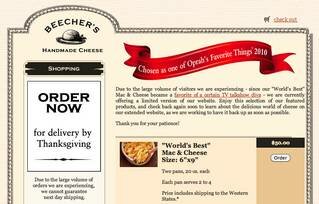 [UPDATE: Giveaway is over.] "Due to the large volume of visitors we are experiencing--since our "World's Best" Mac & Cheese became a favorite of a certain TV talkshow diva--we are currently offering a limited version of our website," explains Beechershandmadecheese.com.
[UPDATE: Giveaway is over.] "Due to the large volume of visitors we are experiencing--since our "World's Best" Mac & Cheese became a favorite of a certain TV talkshow diva--we are currently offering a limited version of our website," explains Beechershandmadecheese.com.
Turns out the "World's Best" Mac & Cheese from Beecher's is a claim Oprah might stand behind. To celebrate the sudden fame, Beecher's is giving away--that's free, folks!--hot dishes of mac & cheese until close of business (6 p.m.) today, November 19. You have three locations to choose from: their Pike Place store, Pasta & Co. at University Village, and Bennett's Pure Food Bistro on Mercer Island.
'Scuse us. Gotta run.
As I start posting reports about the local food scene as well as culinary escapes from Seattle, I thought it would be interesting to share a perspective on the sometimes hard-to-define Pacific Northwest cuisine.
I enlisted the help of Lorna Yee, a local food writer who just co-authored The Newlywed Kitchen: Delicious Meals for Couples Cooking Together. Yee has an adventurous appetite and is one of the people in Seattle I most trust for restaurant recommendations.
As someone who's lived in both Vancouver and Seattle and has spent time exploring the food scene in Portland, how would you define Pacific Northwest cuisine?
Pacific Northwest cuisine seems to center around salmon, shellfish, and foraged ingredients like fiddlehead ferns and morels. There's a bit of Asian influence, of course, though Vancouver chefs like Rob Feenie (ex-Lumiere), Seattle chefs like Tom Douglas, and Portland chefs like John Gorham seem to draw inspiration from around the world and apply it to the ingredients most readily found in their hometowns. There doesn't seem to be a "right" or "wrong" way to do things here—we don't have an almost religious (and admirable!) adherence to certain recipes and culinary traditions, like they do in the South. Chefs here are constantly innovating: there's no lack of creativity here in the Pacific Northwest.
Having recently moved to Seattle, how would you refine your definition of Pacific Northwest cuisine to make it more Seattle-specific?
Seattle is an incredibly green city that's focused on sustainability. Shopping at the farmers' market is routine for many of us here, and the "local, seasonal" mantra is not just one we see in restaurant kitchens. Many home cooks have adopted this way of cooking and eating in their kitchens, too.
What are Seattle restaurateurs and chefs doing well?
They are doing a great job of working with the reality that many of us are looking for a more laidback, more affordable dining experience nowadays. Casual sister restaurants, like Luc, or less formal options (like the bar/main dining room of Mistral Kitchen) ensure that restaurateurs are attracting larger clientele.
On the flip side, what's missing or done poorly here?
Asian food—with a few Eastside exceptions—is sorely lacking. Hopefully, with Bellevue's Din Tai Fung opening, we'll see more demand for higher quality Chinese food. I'm not an expert on Indian food, but Indian friends also tell me that they haven't found much excellent Indian food in Seattle proper.
...
Amy Vanderbeck, her sister Katy, and Daniel Perry, all graduates of the Vivace empire, built Watertown Coffee on the grave of Coffee Animals, on 12th Avenue just south of Seattle University.
They opened in early 2009, and look to have been squirreling away board and video games in the cavernous interior ever since. (After months of "meaning to stop in," I was challenged to a ping pong tournament on their new table. The less said about that, the better, although the bourbon and hot apple cider took some of the sting out of defeat.)
There's Vivace coffee, a real bar, and a sandwich/soup/salad food menu. The "rec room" atmosphere--seriously, besides board games, there's an Xbox--surprises people expecting a standard coffee shop, and people used to Starbucks' consistently genial service are clearly taken aback by the staff's "attitude" and the music volume that's at the whim of the barista. (For better photos of the interior than an iPhone can provide, click here.)
Yelpers and Urban Spooners are divided into love it/hate it, and it's-just-a-coffee-shop-relax camps. However, if you are sensitive flower and need quiet study time, you might want to try somewhere else. That is not the aim of Watertown, which has a clubhouse vibe, and where--if you consistently miss ping pong returns and have to chase the ball as it thwocks and pwocks across the room--the baristas won't glance at you twice.
If you attended Blogsgiving last year, you know that it involved drinking and eating cupcakes, and helping out the hungry through a donation to Northwest Harvest. It worked once, so we're trying it again.
This year the contributors of The SunBreak, CHS, CD News, and the whole Neighborlogs network, along with Seattle Metblogs, are gathering at Central Cinema on November 18, from 6 to 9 p.m. We haven't worked out all the details yet, but we do know there will be food, drinks, and festivities.
And we're bringing back our amateur paper-turkey contest. That was huge.
Seattle's first Hard Rock Cafe, located at 116 Pike Street, is open for business today, as of 11 a.m. Josh and Audrey went on a tour yesterday, and here are the photographic results. Here, they chat about what it all means for Seattle.
Generally speaking, I avoid beer festivals. They're always crowded, usually overpriced, and often the beer list isn't all that different from the top two shelves found in one of the many beer shops around town. Belgianfest, however, took no arm-twisting at all for my attendance.
Twenty-five Washington breweries--an impressive figure on its own--came together for one day to showcase a common love: Belgian beer. To have this many breweries on hand offering up their take on over fifty different Belgian style beers is a dream come true. And to top it off, also in attendance were Dante's Inferno Dogs, Bluebird Homemade Ice Cream, and oh-my-god-amazing Sweet Iron Waffles.
First, the space. The Engine Room at Georgetown Studios (the original Rainier Brewery in Georgetown) was the perfect space for this festival--a large, airy room with sky-high ceilings and lofty windows filling the festival with natural sunlight. This made the crowd only more happy to be here.
The only downside to this festival was the epic fail of restroom planning. Hundreds of people drinking ten healthy samples each of beer equates to a hell of a lot more than the two single-stall restrooms on the premises. Luckily, the Jules Maes Saloon across the street was very accommodating to the folks who simply could not wait to do their business. To their credit, the organizers did realize the error of their ways and ordered up a truckload of porta-potties for the evening session....
Note: Part 1 of this Escape from Seattle is here.
Waking up in Whistler, this calorie-lover knew there was a big day of eating ahead.
Just a short walk from my base at the Westin Resort & Spa is Lift Coffee Company, with outdoor seating and a morning menu that tempted me with a coddled egg and smoked black cod. I enjoyed this little glass ramekin of comfort food, accompanied by assorted baby lettuces, grilled rye, and puttanesca vinaigrette.
What most made me want to order this dish? "Shaved Montana," which sounds like a great name for a band, but turned out to be a cheese topping for the salad.
Lift's comfortable outdoor sofas looked tempting for a post-breakfast nap, but those seats have view of the entry point for my next stop: the Whistler Village Gondola, which would take me up nearly 6,000 feet to connect to my PEAK 2 PEAK Alpine Experience.
Choose your Peak 2 Peak gondola correctly, and not only do you have a 360-degree, panoramic view from as high as 1,430 feet from the valley floor, but you might also have floor windows that allow you to look straight to the ground.
For someone who no longer skis, this 2-and-3/4 mile journey was a great way to get a feel for the majesty of the Olympic venue, and a sense of awe in the marvel of construction of the peak-to-peak cable connection. Completion of Peak 2 Peak broke records for longest unsupported span, highest lift of its kind, and longest continuous lift system on the planet....
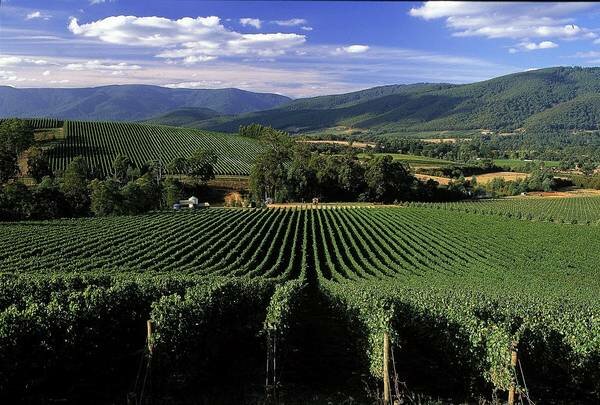 Coldstream Hills, Yarra Valley, Victoria, Australia. Photo by Matt Turner ©Australian Wine and Brandy Corporation
Coldstream Hills, Yarra Valley, Victoria, Australia. Photo by Matt Turner ©Australian Wine and Brandy Corporation
You might not associate pinot noir with Australia, but that won't be for long, if Aussie winemakers have anything to say about it. During the month of June, they're pushing wine drinkers in Los Angeles and Seattle to give up Oregon pinots and try some from Victoria, a state in Southeastern Australia with a cooler climate, good for the persnickety grape. And yes, even though this is white- and rosé-drinking season, a light and supple pinot noir also goes well with most summer meals. I spoke with Mark Davidson, a longtime sommelier and market development manager with Wine Australia about drinking Australian wine and this month's pinot event. Details on restaurants and retailers serving Victorian pinots after the interview.
What are the common perceptions (or misperceptions) of Australian pinots?
Most Americans, if they are aware of Australian pinot noir, they aren't that familiar with it. Without a doubt, New Zealand pinots are better known in the marketplace. (I can't speak about New Zealand, because we hate them—that's just a joke, actually.) When people think of Australia, they think of other things with wine—most likely shiraz is the first thing that comes to mind. I think the idea of Australian pinot noir is a great way to shift people's perception, which is kinda what we're trying to do right now, just to get people to think and understand that there's more to Australian wine than the cheap "sunshine in a bottle" or the steroidal shiraz that they've been accustomed to in the last couple years.
It's almost as if Australia's name was kinda ruined for a while, in terms of wine, because of Yellowtail and the subsequent race to the bottom for the cheapest possible wine.
Yeah, no question, everything goes through ebbs and flows, but in fairness, the kind of wines that got Australia to the dance, if you like, on the North American stage are those fun, varietally correct and clean, affordable wine--that's what got people excited. Then there was a little state where there were some importers bringing in the types of wine that were big and bold and high in alcohol. Those wines certainly exist, but they're not really that traditional in Australia. That got people excited for a short period of time, and then they got bored with those wines.
So then Australia was slotted as a two-trick pony: simple and fruity wines that were affordable, or these monstrous wines that were really big and over-the-top, and that's really not the full picture. While pinot noir is a relatively new thing to Australia, there's all kinds of styles and cool climate grapes that are not new at all and have been made for decades in Australia, but nobody knows about them. People like to compare [Australian pinots] to Oregon pinots. Obviously, the movie Sideways did a fantastic job in many ways of getting people in North America excited about wines other than cabernet....
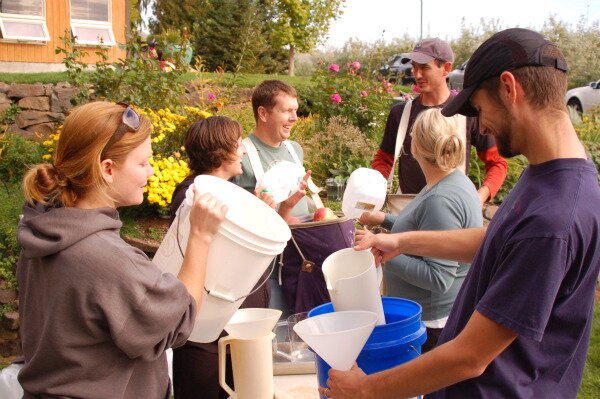 A cider is born in East Wenatchee. (Photo courtesy of Snowdrift Cider Co.)
A cider is born in East Wenatchee. (Photo courtesy of Snowdrift Cider Co.)
I've never liked beer.
And if I hadn't spent time in London during college, that fact might've left me a lifelong teetotaler. But during that trip I discovered hard cider. Every pub had it on tap, and damn, was it good.
Back in the U.S., of course, cider was thin on the ground, especially twenty years ago. That kind of made sense in Milwaukee, where I grew up, which is devoted to beer. But Washington is known for apples. When I moved here, I wondered: Where's the thriving cider scene?
In progress, it turns out. In the last few years especially a number of small cideries have sprung up throughout the northwest. (There's even a Northwest Cider Association.) And a few months ago I stumbled across what I believe is the best cider produced in Washington: Snowdrift, based in East Wenatchee. It's outstanding. I've been drinking it ever since, and it's a tough call to decide between their Cliffbreaks Blend and Wandering Aengus's Bloom as my favorite variety overall.
So I emailed Snowdrift's Lars Ringsrud to ask for an interview and find out more.
You've grown apples for a long time, but you started making hard cider recently. How did you decide to enter that market?
Well our history in cidermaking goes back a couple decades, about as long as we've been growing apples. Peter would occasionally make homemade wines and ciders from the fruit here on the orchard. The wines would generally turn out pretty good, but the cider was never anything you'd actually want to drink--or even cook with for that matter.
Somewhere around 1998-2000 the apple market took a nose dive. We saw orchardists tearing out their orchards left and right because they couldn't get operating loans, and others would replant with Galas, Fujis, Pink Ladies, whatever the newest hot variety was, to try to stay in business, just to have to wait 3-7 years before they even got a crop. We were in the same boat where something had to change, but we went in a different direction....
Today may be the last day of summer, but fall is a fine season for taking culinary-related trips outside of Seattle. Having previously reported on an "Escape from Seattle" to Whistler, it's now time to head south to Portland and then loop up through parts of central Washington to discover good eats (and drinks), as I did this past summer.
Let's start with Portland. You're probably thinking: Oh, not another article about how Portland's food is better than Seattle's. Maybe not better, but different. And when traveling, aren’t we usually looking for something different? I'll offer a few examples, but by no means an exhaustive list.
Portland's got a different food vibe than Seattle. As local food writer Lorna Yee recently remarked about Portland in a SunBreak interview, "the food is a little gutsier, and the scene a little grittier."
The dining spaces are certainly different. It seems Portland chefs and restaurateurs are more creative with their kitchens and dining rooms, as you can eat at carts, strip clubs, and converted industrial spaces. There's the usual glitz and glamor of downtown eateries, but in general, I find the better eats to be on the east side of the Willamette River. (Even if you take the train to Portland—a fun way to travel—you can easily head east by bus and foot. I've done it, and you get to discover more of the city this way.)...
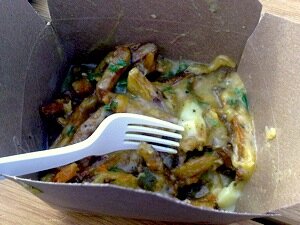 Skillet's poutine, courtesy of The SunBreak Flickr Pool member 7502winona
Skillet's poutine, courtesy of The SunBreak Flickr Pool member 7502winona
Seattle magazine, as a side order of their October issue street food coverage, have cooked up a cool idea, a Mobile Chowdown featuring some of Seattle's favorite food trucks: Marination Mobile, Skillet, Maximus Minimus, Kaosamai Thai, Gert's BBQ, El Camion, Parfait Ice Cream, and Dante's Inferno Dogs.
It's this Saturday, from 11 a.m. to 3 p.m., at 1616 W. Bertona in Interbay. There's also an ongoing Twitter contest for followers of @mobilechowdown. They're asking one question each day from October 1 until October 10, (total of 10 questions) all having to do with the food trucks or the prize providers. The prize is dinner for two at Tilth Restaurant, a night at the Sorrento Hotel, and a year's worth of Seattle magazine.
This is all very good. For a start. But the obvious question is why can't I have my street food in one convenient location all the time? (Convenient, by the way, rules out Interbay.) This kind of forward-thinking is one more area in which Portland has Seattle beat. First of all, Food Carts Portland shames us with its very existence and abundance of wagon-prepared fare.
View Larger Map
But secondly, Portland has a street food corral downtown, where a wagon train of street food vendors have set up shop on the perimeter of what I vaguely remember to be a parking lot. This is a stroke of genius. Downtown workers are always in a rush to get a cheap lunch.
We still have the chance to one-up PDX on this, though.
We could line Occidental Square with carts (or run them down the center). That would give people (besides our wishfully labeled "transient" population) a reason to sit down and enjoy the tables and chairs set out there. If we wanted to progressive about it, we could even use the rent the city charged the carts to fund homeless services in the area. Who do we talk to about getting this going?
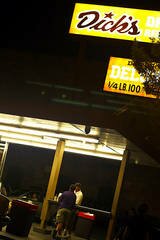 Photo courtesy our Flickr pool's zenobia_joy
Photo courtesy our Flickr pool's zenobia_joy
In the 1960s and '70s, Seattle earned a reputation as a top-notch burger haven. Burger shacks like Turbulent Turtle and Red Robin served up burgers with a dizzying mix of embellishments, and Dick’s Drive-In and Daly’s cooked up an honest, tasty lunch at prices everyone enjoyed.
Sadly, that first generation of patty pioneers now lies moldering in redeveloped graves. A few years ago, Daly’s closed to make way for an Eastlake development that has been stalled by the economy. It’s now just a vacant lot. Earlier this year, the original Red Robin on Eastlake closed, the last link to a glorious past for what is now, basically, a mall-only restaurant. Only Dick’s remains, still serving the best burgers for the dollar in the city.
Thankfully, Seattle is in the midst of a burger shack renaissance and The SunBreak Lunch Team (not just for breakfast anymore!) has spent the past few weeks scouting out the new players.
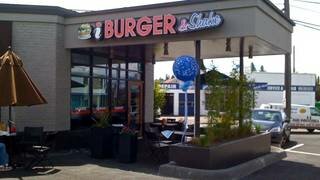 iBurger and Shake (8000 Lake City Way N.E.) just opened. Housed in a beautifully restored 1930s-era gas station, it’s a welcome addition to the lunch landscape in Maple Leaf. We ordered the Cheeseburger and the Hawaiian Burger with chicken. A blueberry shake and an order of fries rounded out the meal.
iBurger and Shake (8000 Lake City Way N.E.) just opened. Housed in a beautifully restored 1930s-era gas station, it’s a welcome addition to the lunch landscape in Maple Leaf. We ordered the Cheeseburger and the Hawaiian Burger with chicken. A blueberry shake and an order of fries rounded out the meal.
The burgers are 1/3-lb. of 100-percent ground chuck and are delicious. Lettuce, onions, and tomato were crisp and fresh. The chicken was a large portion, well cooked but not dry. The shake was fresh blueberries mixed into soft-serve ice cream. The fries were crinkle-cut and disappointing. Prices were reasonable, with burgers in the $4 to $7 range. The two of us ate a good meal for $16....
 Our annual social hour and fundraiser for Northwest Harvest is tonight, November 15! Visit our Facebook invitation page for more details and to RSVP.
Our annual social hour and fundraiser for Northwest Harvest is tonight, November 15! Visit our Facebook invitation page for more details and to RSVP.
Join the writers and readers of such blogs as Rainier Valley Post, SouthendSeattle, CD News, Capitol Hill Seattle, and Seattlest for some fun with YouTube, a beer tasting courtesy of Newcastle Brown Ale*, and a limited supply of complimentary pizza from Tutta Bella.
This year we're going to be meeting up in Columbia City, at the Bourbon Bar (4916 Rainier Ave. S.) from 6 to 9 p.m.
If pizza and beer isn't enough, know that the Bourbon Bar also has a new bar menu of small plates and, you guessed it, a wonderful selection of bourbon.
We're also hooking the bar's TV up to the internets for the evening, so help us build a YouTube playlist by posting your favorite(s) in the comments.
All of this for just a $5 suggested donation at the door, or two cans of food. See you there!
*Please enjoy the one and only Newcastle Brown Ale responsibly.
 When Seattle Magazine decided to throw a street food extravaganza, it sounded like a great idea: tons of mobile food carts, collected together in one place, providing mini-bites. What could possibly go wrong?
When Seattle Magazine decided to throw a street food extravaganza, it sounded like a great idea: tons of mobile food carts, collected together in one place, providing mini-bites. What could possibly go wrong?
But the first Mobile Chowdown, held last October, turned out to be a clusterfuck of epic proportions: poorly organized, misused space, crazy-long lines, and carts running out of food. It was a post-apocalyptic hellscape *thisclose* to being The Road. Everyone I know who went took one look at the mess and left. Those who stayed suffered. (Seattle, the only city in the world where folks will patiently wait in line for hours, and then complain.)
Tomorrow (11 a.m.-3 p.m.) marks the second attempt, and word is that this time around, organizers have taken steps to ensure it runs a little more smoothly. The site's the same--the parking lot at 1616 W. Vertona--but now the carts will be spaced farther apart to keep the space organized. There will also be more staff on hand to help direct people, more clearly designated vendor line areas, and plenty o' port-a-potties. Because yes, even that was a problem last time around. ...
Actually, the last time I was in Ivar's, I noticed the $0.75 cup of chowder, but settled on the bowl, thinking I'd pay full freight. When the bill came, it was $1.50. So, full disclosure, I'm not all that worked up about the billboard hoax/prank, even though I asked my waiter for the straight dope. An underwater billboard campaign aimed at nonexistent submarines strained credulity.
The Seattle Times sounds a little nettled though. Executive Editor David Boardman says they are reviewing their relationship with Paul Dorpat, the local historian who vouched for the authenticity of the underwater billboard campaign, saying "As far as I can tell, it's the real thing."
The Times took Dorpat at his word, it sounds like, and never checked to see if the price was correct for 1955 (it wasn't) or noticed that the "wrong governor was put on the letterhead from the Department of Fisheries." But maybe this is the attitude a very important newspaper must take. Public trust, and all.
The important news here is that the...
If there's a vanguard for the back-to-the-future, "Victory Garden" era in horticulture and landscaping, Colin McCrate is leading it. As the recession stretches out, garden-happy Seattleites are switching flowerbeds and shrubs into edible greens, fruits, and vegetables. At McCrate’s Seattle Urban Farm Company, the requests for residential farm landscaping (and chicken coops) keep increasing.
"It’s definitely true," said McCrate, atop Ballard's Bastille restaurant (5307 Ballard Ave. N.W.), where he's installed a prototype rooftop garden. "More and more people are taking advantage of yard space to supplement their food needs. The sale of vegetable seeds has gone through the roof."
Seattle’s climate, even in a cloud-shrouded summer like the one we are currently experiencing, is perfect for cultivation of greens, herbs, vegetables and fruit, particularly native apples, cherries and plums. Rain and peek-a-boo sun makes for perfect growing conditions.
Some local gardeners have always made a sport of growing food products, and Seattle’s P-Patch network has been flourishing since the hippie-intensive 1970s. But now, people are farming for keeps, both residentially and commercially.
"Our customers are constantly surprised at the yield from even a small plot," McCrate commented.
A few years ago, Bastille's James Weimann and Demming Maclise purchased a building on the resurgent Ballard Avenue. (If you haven’t been over there recently, make plans. It’s as nice a mix of retail and restaurants in the city). Their goal was to create a restaurant that adhered to the strict demands of French cuisine, namely the use of fresh ingredients. They succeeded in spades, but not before an intensive remodel and some bold thinking....
So many in Seattle are atwitter with Canlis' menu contest. And rightly so. In hiding 50 menus in 50 days (Sundays off, generally), Canlis is providing 50 lucky Seattleites the chance to dine (with a guest) at 1950s prices. It's all part of Canlis' 60th birthday celebration.
The contest is brilliant on many levels. First, the clue-giving is a fantastic use of social media. Second, it's intellectually stimulating, as the answers often emerge from riddles, plays-on-words, etc. Related to that, the contest connects Canlis and all the contestants (and that's anyone) to Seattle, teaching a lot about regional history in the process. And finally, it's hip, bringing a new generation of fans into the Canlis fold.
For those not fortunate enough to find a menu, I always say that you can enjoy the splendor of Canlis by enjoying a bite (maybe teriyaki, or dessert and a drink?) in the bar area. Better yet, instead of a $2.75 salmon steak or $3.85 filet mignon from that 1950s menu, see how Canlis has changed by checking out the chef's tasting menu. Here's what Jason Franey is serving up this fall:
Amuse Bouche: Sunchoke soup and white truffle ice cream (this connected to the amazing white truffle menu that I enjoyed the same night)...
If you haven't been in recently, or have been waiting for someone to offer you their chocolate dessert named El Diablo, you're in luck. Throughout April, Tango has a full slate of special events in celebration of turning ten years old. The party begins April 1, with free El Diablos, and continues $5 pairings of El Diablos and specialty tequilas, live tango, extended happy hours, and participation in the meal deals of Seattle Restaurant Week.
To get out the word on Tango turning ten, Travis Rosenthal had a swarm of food writers down to the corner of Boren and Pike this week to preview the cause for celebration. Rosenthal's owned Tango since 2006--he originally arrived in Seattle to help open Pacific Place's Il Fornaio, and was general manager at the U Village's popular Piatti, until making the leap to Tango's Latin American and Spanish small plates.
Rosenthal and his executive chef Michael Bruno were confident enough in their offerings that they opened the whole menu for review (see the photo gallery above). Missteps were few and far between, and I began asking myself more and more stridently why it had taken me ten years to darken their door. To read the reviews, everyone else clued in long ago. The candlelit ambiance draws everyone from canoodling couples and Paramount showgoers, to carafe-quaffing tables of ya-ya sisterhoods.
The most delightful experience when cooking is to finally master something you’ve repeatedly messed up before. It gives one a sense of possibility--in cooking and in life. For me, this happened when first I made Ruth Reichl’s recipe for Spaghetti Carbonara.
Spaghetti Carbonara is meant to be eaten on cold nights in large bites and gulps. Made with eggs and bacon, it’s more sophisticated than the universally-beloved spaghetti with butter and parmesan, yet only slightly more complicated, and perfect when made for one or two.
Spaghetti Carbonara is a simple dish, but badly done, it’s really dreadful. I know, I’ve botched it before. First there was the time I made it for staff meal at the fancy restaurant where I worked. I dumped several pounds of hot cooked pasta into the eggs and lo and behold, the heat held by five pounds of pasta completely scrambled them--making a dish of dry pasta and coagulated egg. At least there was still bacon. Then there was the time that I ignored Ruth's recipe and tried to get away...
While Jay will surely address the Seattle food scene, summer and fall are excellent times for excursions, so he’ll also spotlight some accessible food and fun in an "Escape from Seattle" series.
Whistler. Coming off this year’s Winter Olympics, the name conjures up images of graceful and powerful athletes wearing skis and riding luges. Even in the height of summer, there’s snow on the slopes and people (mostly young, mostly with snowboards, and mostly texting while riding up the lifts--or so it seems) ascending high above the village, eventually coming down to earth along with fit hikers and ferocious mountain bikers.
Whistler must be one of the fittest places in North America; there’s a lot of beefcake and bodacious bods—healthy people showing off rippling muscles and summer tans.
And then there’s me.
My exercise: hustling from one eatery to another, and then thinking about ways to burn off some calories before inevitably just relaxing or even napping. Some are calorie burners; I, in contrast, am more of a calorie lover.
Not completely, though. In my one previous visit to Whistler, about fifteen years ago, I found myself in a canoe, struggling to row around a lake. And then, afterward, back to my real sport: struggling to find a decent place to eat. A struggle it was. But now, having heard rumblings that the food scene had improved, it was time for a return visit.
In Vancouver, I reluctantly put away my list of dim sum palaces and ramen joints, and skeptically boarded the Rocky Mountaineer to ride the rails to Whistler. While the trip proved that train food is much like plane food (it’s plain food, indeed), the service was stunning, and the scenery spectacular on the sea-to-sky climb.
Leaving urban for countryside, I found myself quickly relaxed, enjoying the views while sipping post-breakfast wine. My only exercise during those three hours: getting up for occasional walks to the open-air Heritage Observation Car when attendants cued us for photo opportunities of Pacific waters, snow-capped mountains, and cascading waterfalls. Little did I realize how making the 74-mile trip by rail, without worry about watching the road, would be such a wonderful experience....
Two Christmases ago, I published two delicious candy recipes in a magazine printed on real paper. It’s true. You can ask my mom to show you one of her nine copies. These recipes, for soft caramels and peppermint marshmallows, are still among my holiday favorites, but since my friends did not leap at the chance to make the candies themselves, I had to wonder.
Either my friends considered it supportive enough to simply eat candy that I had already made (weak) or, perhaps the required candy thermometers proved too much for them. Time and continued interaction with non-food professionals has led me to see that most people don’t like candy thermometers--they believe thermometers to be indicative of exacting recipes, recipes that require accuracy and hold the potential for messy, sugary failure.
Luckily, there also exist easy, thermometer-free candy recipes and for Christmas, I’m going to give you one.
This toffee (you could also call it brittle, but I like to affect British-ness, so toffee it is) is basically a classic butter toffee with toasted almonds mixed it. It can be dipped in a chocolate glaze, or left plain--it’s delicious either way. It’s also quite fancy-looking and can be happily packed into bags and boxes to be given away as presents.
Now, I would be lying if I didn’t warn you that candy-making is different from other kinds of cooking for the obvious reason that it involves molten hot sugar. Try to think of this as exciting, rather than terrifying. To assuage your fears, below is a somewhat long-winded, but extremely useful overview of candy-making that a magazine would have happily cut out (many thanks, kind SunBreak editors). Below that, is the recipe itself. Enjoy.
When you make any caramelized sugar and butter/cream type candy, this is what’s going to happen. First you’re going to cook some sugar with a little bit of corn syrup and water until it comes to a boil. You’re not even going to think about stirring it. Stirring the mixture at this point can cause it to seize, meaning to turn from a liquid into a solid clump of crystallized sugar. Bad.
Next, you’re going to add a lot of butter (or in the case of soft caramels, cream); the mixture will bubble and souffle up in a way that is not un-terrifying to some, but that won’t bother you at all because you will either be using a long-handled whisk or wearing one of these babies.
Then you’re going to whisk and whisk and continue to cook over high heat until the mixture turns the a nice light amber color. You’re going to add a couple last minute things and then, carefully and without burning anyone, you are going to pour the candy out onto a sheet pan that you have already prepared. Done. Now relax.
Also: I’ve just been informed that the caramel and marshmallow recipes are no longer available on the ReadyMade site. If you want ‘em, just say so in the comments....
Hello!
Twitter: @thesunbreak | Facebook
iPhone app download (Free!)
Subscribe to The SunBreak
Delivery Options
![]() Subscribe to all SunBreak Stories
Subscribe to all SunBreak Stories
Daily Email Digest of The SunBreak
Most Viewed Stories
- Hie Yourself to Beecher's for Free Mac & Cheese ('til Closing Tonight)
- Mental Illness Drove Capitol Hill's Hatchet Killer
- Tens of Thousands in State May Lose Federal Unemployment Benefits
- McDonald's Adds Insult to Injury with Local Billboard Campaign
- Iron Chefs Galore at CIA's Worlds of Flavor Conference
Latest Headlines
- First Things First, Seahawks! Fix the Music
- Dayna Hanson's Indie Rock-Driven Dance-Theatre Take on American History
- The Deep-Bore Tunnel: New Extended Edition with Added Commentary
- If We're Choosing Debuts, I'll Take "A Christmas Story" and New York Can Have "Spider-Man"
- Glimpses: "YIP 2010.332 - Checkmate"
Recently in Our Flickr Photo Pool
www.flickr.com
|
Our Facebook Fan Page
Neighborhood Blog News
Niche Blog News
Seattle Weather
Get the SunBreak iPhone App

Download the SunBreak iPhone app for free.
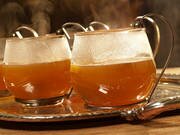
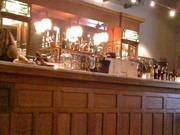


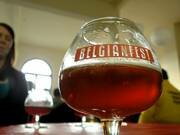
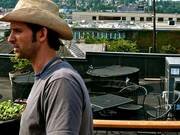

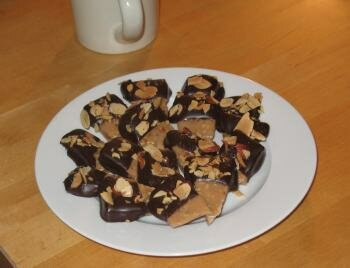



Most Recent Comments